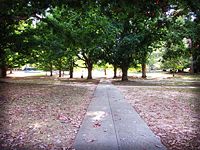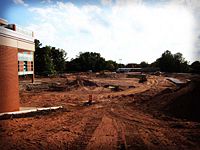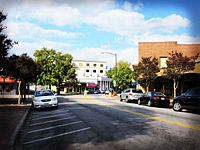Pictures of our Landscapes Clemson Group 1
---> Back to overview of groups
Authors: Hanna, Koschnitzski, McLaughlin, Ogletree, Yonce
Images
Description
The first image presented by our group demonstrates the sociocultural aspects of Clemson University’s campus through the depiction of a site representing a myriad of functions and meanings. This particular site is the shaded field surrounding the Trustee House. The first noticeable quality about this area is the quality of space provided by the old-growth shade trees. Clemson boasts many such old-growth oak trees that have become iconic in their stature and quality of presence. This attachment to historical, horticultural elements is indicative of Clemson University’s relationship to the landscape. On football weekends, this open space is home to a multitude of tailgaters, activating the space with their own community-driven purposes. This aspect is an important element of the Clemson alumni family and related importance placed upon tradition and community spirit. Another quickly visible aspect of this site is the feature of names engraved along the asphalt pathways that traverse the open space. These names reflect the graduating members of the classes that donated to provide these walkways and exist as a reminder of the caliber of individuals who have come through Clemson’s degree programs and their continued investment in Clemson’s progress and commitment to academic excellence. This shaded grove is also indicative of the kind of shaded spaces that are valuable to the climate of the area, providing cool respite for pedestrian travel across campus.
The second image presents the future grounds of the new Lee Hall expansion. This site under construction is indicative of the progressive nature of academia and the growing demands of Clemson University’s campus. While many trees had to be uprooted to provide the space for this new development, the proposed Lee Hall Expansion is designed with a keen eye for state-of-the-art advancements in green architecture. Clemson University is continually seeking ways to improve its status as an environmentally responsible institution. These efforts include creating a new sustainability commission, a new sustainability plan for the campus, as well as an agenda to reach carbon neutrality by the year 2030. The site itself unveils the rich red clay that is the predominant soil type in the area and is iconic to South Carolina’s upstate. The current efforts to invest in a new expansion also represent Clemson University’s continued commitment to providing high-quality conditions for academic research and development.
The third image depicts the downtown core of Clemson, which is the commercial and night-life hub for many of Clemson University’s students. Home to several bars, this corridor is regularly overflowing with students on the weekends, enjoying the community within academia. In addition, this commercial district exhibits multiple Clemson paraphernalia shops (further demonstrating the die-hard support of fans and alumni alike) as well as several food and service providers. Any typical introduction to Clemson’s campus would likely include the cultural stamp that this downtown core provides through its importance to the social life of Clemson’s students.


